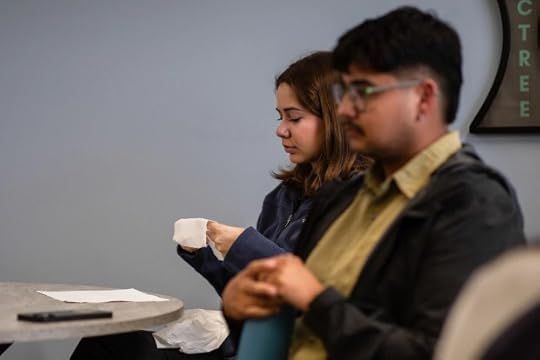Jeremy T. Ringfield's Blog, page 119
May 26, 2025
Another casualty of Trump research cuts? California students who want to be scientists
This spring, the National Institutes of Health quietly began terminating programs at scores of colleges that prepared promising undergraduate and graduate students for doctoral degrees in the sciences.
At least 24 University of California and California State University campuses lost training grants that provided their students with annual stipends of approximately $12,000 or more, as well as partial tuition waivers and travel funds to present research at science conferences. The number of affected programs is likely higher, as the NIH would not provide CalMatters a list of all the cancelled grants.
Cal State San Marcos, a campus in north San Diego County with a high number of low-income learners, is losing four training grants worth about $1.8 million per year. One of the grants, now called U-RISE, had been awarded to San Marcos annually since 2001. San Marcos students with U-RISE stipends were often able to forgo part-time jobs, which allowed them to concentrate on research and building the skills needed for a doctoral degree.
The cuts add to the hundreds of millions of dollars of grants the agency has cancelled since President Donald Trump took office for a second term.
To find California campuses that lost training grants, CalMatters looked up known training grants in the NIH search tool to see if those grants were still active. If the grant’s award number leads to a broken link, that grant is dead, a notice on another NIH webpage says.
The NIH web pages for the grants CalMatters looked up, including U-RISE, are no longer accessible. Some campuses, including San Marcos, Cal State Long Beach, Cal State Los Angeles and UC Davis, have updated their own websites to state that the NIH has ended doctoral pathway grants.
“We’re losing an entire generation of scholars who wouldn’t have otherwise gone down these pathways without these types of programs,” said Richard Armenta, a professor of kinesiology at San Marcos and the associate director of the campus’s Center for Training, Research, and Educational Excellence that operates the training grants.
At San Marcos, 60 students who were admitted into the center lost grants with stipends, partial tuition waivers and money to travel to scientific conferences to present their findings.
From loving biology to wanting a doctoral degreeBefore the NIH terminations, Marisa Mendoza, a San Marcos undergraduate, received two training grants. As far back as middle school, Mendoza’s favorite subjects were biology and chemistry.
To save money, she attended Palomar College, a nearby community college where she began to train as a nurse. She chose that major because it would allow her to focus on the science subjects she loved. But soon Mendoza realized she wanted to do research rather than treat patients.
At Palomar, an anatomy professor introduced her to the NIH-funded Bridges to the Baccalaureate, a training grant for community college students to earn a bachelor’s and pursue advanced degrees in science and medicine.
“I didn’t even know what grad school was at the time,” she said. Neither of her parents finished college.
The Bridges program connected her to Cal State San Marcos, where she toured different labs to find the right fit. At the time she was in a microbiology course and found a lab focused on bacteria populations in the nearby coastal enclaves. The lab was putting into practice what she was learning in the abstract. She was hooked.
“It just clicked, like me being able to do this, it came very easily to me, and it was just something that I came to be very passionate about as I was getting more responsibility in the lab,” Mendoza said.
 Marisa Mendoza, right, and Camila Valderrama-Martínez, left, get ready to demonstrate how they use lab equipment for their research work at Cal State San Marcos on May 6, 2025. (Adriana Heldiz - CalMatters)
Marisa Mendoza, right, and Camila Valderrama-Martínez, left, get ready to demonstrate how they use lab equipment for their research work at Cal State San Marcos on May 6, 2025. (Adriana Heldiz - CalMatters) Equipment and testing samples at a reasearch lab at Cal State San Marcos on May 6, 2025. (Adriana Heldiz - CalMatters)
Equipment and testing samples at a reasearch lab at Cal State San Marcos on May 6, 2025. (Adriana Heldiz - CalMatters)From Palomar she was admitted as a transfer student to San Marcos and more selective campuses, including UCLA and UC San Diego. She chose San Marcos, partly to live at home but also because she loved her lab and wanted to continue her research.
She enrolled at San Marcos last fall and furthered her doctoral journey by receiving the U-RISE grant. It was supposed to fund her for two years. The NIH terminated the grant March 31, stripping funds from 20 students.
For a school like San Marcos, where more than 40% of students are low-income enough to receive federal financial aid called Pell grants, the loss of the NIH training awards is a particular blow to the aspiring scientists.
The current climate of doctoral admissions is “definitely at a point where one needs prior research experience to be able to be competitive for Ph.D. programs,” said Elinne Becket, a professor of biological sciences at Cal State San Marcos who runs the microbial ecology lab where Mendoza and other students hone their research for about 15 hours a week.
 Equipment and testing samples at a reasearch lab at Cal State San Marcos on May 6, 2025. (Adriana Heldiz - CalMatters)
Equipment and testing samples at a reasearch lab at Cal State San Marcos on May 6, 2025. (Adriana Heldiz - CalMatters)San Marcos doesn’t have much money to replace its lost grants, which means current and future San Marcos students will “100%” have a harder time entering a doctoral program, Becket added. “It keeps me up at night.”
Research is ‘a missing piece’In a typical week in Becket’s lab, Mendoza will drive to a nearby wetland or cove to retrieve water samples — part of an ongoing experiment to investigate how microbial changes in the ecosystem are indications of increased pollution in sea life and plants. Sometimes she’ll wear a wetsuit and wade into waters a meter deep.
The next day she’ll extract the DNA from bacteria in her samples and load those into a sequencing machine. The sequencer, which resembles a small dishwasher, packs millions or billions of pieces of DNA onto a single chip that’s then run through a supercomputer a former graduate student built.
“Once I found research, it was like a missing piece,” Mendoza, a Pell grant recipient, said through tears during an interview at Cal State Marcos. Research brought her joy and consumed her life “in the best way,” she added. “It’s really unfortunate that people who are so deserving of these opportunities don’t get to have these opportunities.”
 Student Marisa Mendoza gets emotional while she speaks about her research at Cal State San Marcos on May 6, 2025. (Adriana Heldiz - CalMatters)
Student Marisa Mendoza gets emotional while she speaks about her research at Cal State San Marcos on May 6, 2025. (Adriana Heldiz - CalMatters)The origins of the San Marcos training center date back to 2002. Through it, more than 160 students have either earned or are currently pursuing doctoral degrees at a U.S. university.
The grant terminations have been emotionally wrenching. “There had been so many tears in my household that my husband got me a puppy,” said Denise Garcia, the director of the center and a professor of biological sciences.
Garcia recalls that in March she was checking a digital chat group on Slack with many other directors of U-RISE grants when suddenly the message board lit up with updates that their grants were gone. At least 63 schools across the country lost their grants, NIH data show.
In the past four years of its U-RISE grant the center has reported to the NIH that 83% of its students entered a doctoral program. That exceeds the campus’s grant goal, which was 65% entering doctoral programs.
Mendoza is grateful: She was one of two students to win a campus scholarship that’ll defray much, but not all, of the costs of attending school after losing her NIH award. That, plus a job at a pharmacy on weekends, may provide enough money to complete her bachelor’s next year.
Others are unsure how they’ll afford college while maintaining a focus on research in the next school year.
 Student Camila Valderrama-Martínez in a lab at Cal State San Marcos on May 6, 2025. (Adriana Heldiz - CalMatters)
Student Camila Valderrama-Martínez in a lab at Cal State San Marcos on May 6, 2025. (Adriana Heldiz - CalMatters)“You work so hard to put yourself in a position where you don’t have to worry, and then that’s taken away from you,” said Camila Valderrama-Martínez, a first-year graduate student at San Marcos who also earned her bachelor’s there and works in the same lab as Mendoza. She was in her first year of receiving the Bridges to the Doctorate grant meant for students in master’s programs who want to pursue a biomedical-focused doctoral degree. The grant came with a stipend of $26,000 annually for two years plus a tuition waiver of 60% and money to attend conferences.
She can get a job, but that “takes away time from my research and my time in lab and focusing on my studies and my thesis.” She relies solely on federal financial aid to pay for school and a place to live. Getting loans, often anathema for students, seems like her only recourse. “It’s either that or not finish my degree,” she said.
Terminated NIH grants in detailThese grant cancellations are separate from other cuts at the NIH since Trump took office in January, including multi-million-dollar grants for vaccine and disease research. They’re also on top of an NIH plan to dramatically reduce how much universities receive from the agency to pay for maintaining labs, other infrastructure and labor costs that are essential for campus research. California’s attorney general has joined other states led by Democrats in suing the Trump administration to halt and reverse those cuts.
In San Marcos’ case, the latest U-RISE grant lasted all five years, but it wasn’t renewed for funding, even though the application received a high score from an NIH grant committee.
Armenta, the associate director at the Cal State San Marcos training center, recalled that his NIH program officer said that though nothing is certain, he and his team should be “cautiously optimistic that you would be funded again given your score.” That was in January. Weeks later, NIH discontinued the program.
He and Garcia shared the cancellation letters they received from NIH. Most made vague references to changes in NIH’s priorities. However, one letter for a specific grant program cited a common reason why the agency has been cancelling funding: “It is the policy of NIH not to prioritize research programs related to Diversity (sic), equity, and inclusion.”
That’s a departure from the agency’s emphasis on developing a diverse national cadre of scientists. As recently as February, the application page for that grant said “there are many benefits that flow from a diverse scientific workforce.”
Future of doctoral programs unclearJosue Navarrete graduated this spring from Cal State San Marcos with a degree in computer science. Unlike the other students interviewed for this story, Navarrete, who uses they/them pronouns, was able to complete both years of their NIH training grant and worked in Becket’s lab.
But because of the uncertain climate as the Trump administration attempts to slash funding, Vanderbilt University, which placed Navarrete on a waitlist for a doctoral program, ultimately denied them admission because the university program had to shrink its incoming class, they said. Later, Navarrete met a professor from Vanderbilt at a conference who agreed to review their application. The professor said in any other year, Navarrete would have been admitted.
The setback was heartbreaking.
 Josue Navarrete at the Cal State San Marcos campus on May 6, 2025. (Adriana Heldiz - CalMatters)
Josue Navarrete at the Cal State San Marcos campus on May 6, 2025. (Adriana Heldiz - CalMatters)“I’m gripping so hard to stay in research,” Navarrete said. With doctoral plans delayed, they received a job offer from Epic, a large medical software company, but turned it down. “They wanted me to be handling website design and mobile applications, and that’s cool. It’s not for me.”
Valderrama-Martinez cited Navarrete’s story as she wondered whether doctoral programs at universities will have space for her next year. “I doubt in a year things are going to be better,” she said.
She still looks forward to submitting her applications.
So does Mendoza. She wants to study microbiology — the research bug that bit her initially and brought her to San Marcos. Eventually she hopes to land at a private biotech firm and work in drug development.
“Of course I’m gonna get a Ph.D., because that just means I get to do research,” she said.
Trump honors fallen soldiers at Arlington, calling them ‘America’s best and bravest’
By SEUNG MIN KIM, Associated Press
ARLINGTON, Va. (AP) — President Donald Trump paid tribute to fallen service members during a Memorial Day ceremony at Arlington National Cemetery on Monday, in an address that honored the “great, great warriors” yet also briefly veered into politics as he boasted of a nation he is “fixing after a long and hard four years.”
Though the holiday is one that U.S. presidents typically treat with pure solemnity, Trump began it with an all-caps Memorial Day social media post that attacked his predecessor and called federal judges who have blocked his deportation initiatives “monsters who want our country to go to hell.”
Yet at Arlington National Cemetery, where more than 400,000 have been laid to rest, Trump commemorated the sacrifice of U.S. service members and singled out several Gold Star families to tell the stories of their fallen relatives.
 President Donald Trump, Vice President JD Vance, Secretary of Defense Pete Hegseth and Major General Trevor Bredenkamp, commanding general of the Joint Task Force-National Capital Region and the U.S. Army Military District of Washington, right, attend a Memorial Day wreath laying ceremony at Arlington National Cemetery, in Arlington, Va., Monday, May 26, 2025. (AP Photo/Jacquelyn Martin)
President Donald Trump, Vice President JD Vance, Secretary of Defense Pete Hegseth and Major General Trevor Bredenkamp, commanding general of the Joint Task Force-National Capital Region and the U.S. Army Military District of Washington, right, attend a Memorial Day wreath laying ceremony at Arlington National Cemetery, in Arlington, Va., Monday, May 26, 2025. (AP Photo/Jacquelyn Martin) President Donald Trump and Vice President JD Vance salute during the 157th National Memorial Day Observance at Arlington National Cemetery, Monday, May 26, 2025, in Arlington, Va. (AP Photo/Jacquelyn Martin)
President Donald Trump and Vice President JD Vance salute during the 157th National Memorial Day Observance at Arlington National Cemetery, Monday, May 26, 2025, in Arlington, Va. (AP Photo/Jacquelyn Martin) President Donald Trump delivers the Memorial Day Address at the 157th National Memorial Day Observance at Arlington National Cemetery, Monday, May 26, 2025, in Arlington, Va., as Vice President JD Vance and Secretary of Defense Pete Hegseth, right, look on. (AP Photo/Julia Demaree Nikhinson)
President Donald Trump delivers the Memorial Day Address at the 157th National Memorial Day Observance at Arlington National Cemetery, Monday, May 26, 2025, in Arlington, Va., as Vice President JD Vance and Secretary of Defense Pete Hegseth, right, look on. (AP Photo/Julia Demaree Nikhinson) President Donald Trump, standing right, salutes at the Tomb of the Unknown Soldier, on Memorial Day at Arlington National Cemetery, in Arlington, Va., Monday, May 26, 2025. (AP Photo/Jacquelyn Martin)
President Donald Trump, standing right, salutes at the Tomb of the Unknown Soldier, on Memorial Day at Arlington National Cemetery, in Arlington, Va., Monday, May 26, 2025. (AP Photo/Jacquelyn Martin) President Donald Trump delivers the Memorial Day Address at the 157th National Memorial Day Observance at Arlington National Cemetery, Monday, May 26, 2025, in Arlington, Va. (AP Photo/Julia Demaree Nikhinson)
President Donald Trump delivers the Memorial Day Address at the 157th National Memorial Day Observance at Arlington National Cemetery, Monday, May 26, 2025, in Arlington, Va. (AP Photo/Julia Demaree Nikhinson) President Donald Trump, right, salutes at the Tomb of the Unknown Soldier, on Memorial Day at Arlington National Cemetery, in Arlington, Va., Monday, May 26, 2025. (AP Photo/Jacquelyn Martin)Show Caption1 of 6President Donald Trump, Vice President JD Vance, Secretary of Defense Pete Hegseth and Major General Trevor Bredenkamp, commanding general of the Joint Task Force-National Capital Region and the U.S. Army Military District of Washington, right, attend a Memorial Day wreath laying ceremony at Arlington National Cemetery, in Arlington, Va., Monday, May 26, 2025. (AP Photo/Jacquelyn Martin)Expand
President Donald Trump, right, salutes at the Tomb of the Unknown Soldier, on Memorial Day at Arlington National Cemetery, in Arlington, Va., Monday, May 26, 2025. (AP Photo/Jacquelyn Martin)Show Caption1 of 6President Donald Trump, Vice President JD Vance, Secretary of Defense Pete Hegseth and Major General Trevor Bredenkamp, commanding general of the Joint Task Force-National Capital Region and the U.S. Army Military District of Washington, right, attend a Memorial Day wreath laying ceremony at Arlington National Cemetery, in Arlington, Va., Monday, May 26, 2025. (AP Photo/Jacquelyn Martin)Expand“We just revere their incredible legacy,” Trump said. “We salute them in their eternal and everlasting glory. And we continue our relentless pursuit of America’s destiny as we make our nation stronger, prouder, freer and greater than ever before.”
“Their valor,” he said, “gave us the freest, greatest and most noble republic ever to exist on the face of the earth. A republic that I am fixing after a long and hard four years.”
During his remarks, Trump told the story of Navy Senior Chief Petty Officer Shannon Kent, killed along with three other Americans by a suicide bomber in 2019 in Syria, leaving behind her husband, 3-year-old son and 18-month-old son.
The Pine Plains, New York, native was on her fifth combat deployment, he said, embedded with a team hunting Islamic State group militants in Syria, serving as linguist, translator and cryptologic technician working alongside special forces.
“She was among the first women ever to do it, and she did it better than anyone,” Trump said, calling out Kent’s family for applause at the ceremony.
The crowd also heard of Air Force Senior Master Sgt. Elroy Harworth from Erhard, Minnesota, whose plane went down in enemy territory during the Vietnam War, dying while his wife was seven months pregnant. His son, who was cheered in the audience, followed his father’s path and has been in the Army for 20 years.
There was also the story of Army Cpl. Ryan McGhee of Fredericksburg, Virginia, who enlisted after the Sept. 11, 2001, attacks and whose mother was in the audience.
Trump said McGhee knew he wanted to be an Army Ranger since he saw the towers fall on that day, did three tours in Afghanistan, then deployed to Iraq. Sixteen years ago this month, the president said, McGhee died in a firefight, and “gave his life at 21 years old.”
Vice President JD Vance, who spoke before Trump, said the lesson of all the gravestones is: “We must be cautious in sending our people to war.” He urged the crowd to push political leaders to treat the lives of soldiers as the “most precious resource.”
Later in his remarks, Trump pointed to a “big, big celebration” coming next year as the U.S. celebrates its 250th birthday, joking that “in some ways, I’m glad I missed that second term” when he lost to Joe Biden.
“Because I wouldn’t be president for that,” Trump said, as the crowd laughed. “In addition, we have the World Cup and we have the Olympics. Can you imagine? I missed that four years. And now look what I have, I have everything. Amazing the way things work out.”
Prior to speaking, Trump placed a wreath at the Tomb of the Unknown Soldier, a somber tradition for U.S. presidents. The president paused after placing the wreath, then stepped back and saluted during the playing of taps. Vance and Defense Secretary Pete Hegseth joined him.
The president began the day with a decidedly different tone.
Related Articles Rep. Sam Liccardo pushes back against Trump cuts after $50 million loss threatens efforts to rein in coastal erosion Trump says he’ll delay a threatened 50% tariff on the European Union until July President Donald Trump hints at an announcement in the ‘next two days’ on Iran nuclear talks Some states reexamine school discipline as Trump order paves go-ahead Rapidly expanding school voucher programs pinch state budgetsIn a social media message in all capital letters, Trump ranted at Biden, calling him the “scum” who spent the last four years trying to destroy the country with radical leftism and who, he said, left behind an open border.
That was after he posted a separate message proclaiming “HAPPY MEMORIAL DAY!” Wishing people a happy Memorial Day is regarded as verboten because the day is considered a somber one to honor soldiers killed in service.
Vance emphasized as much when he spoke to U.S. Naval Academy graduates in Annapolis on Friday, when he said that he and Trump would “lead the most solemn occasion in our nation, Memorial Day at Arlington Cemetery.
“You will learn as I have that when people say things like ‘Happy Memorial Day,’ you appreciate the sentiment behind it but know that it’s wrong because Memorial Day is not a happy day,” Vance said last week. “Memorial Day is not for those who served and came home, it is for those who served that didn’t.”
SF Giants’ Willy Adames kills rallies in 3-1 series-opening loss in Detroit
Giants manager Bob Melvin insists Willy Adames’ clutch hitting “is going to come.”
It repeatedly did not come in Monday’s 3-1, series-opening loss at Detroit, and Adames’ offensive woes are blindingly reflective of the Giants’ anemic output over the past nine games.
The Giants (31-23) managed just five hits, and none went for extra bases against the American League-leading Tigers (35-20).
Adames went 0-for-4 for a second straight afternoon, and that is not what the Giants banked on when signing him to a seven-year, $182 million deal.
“Obviously, he hasn’t gotten off to the start that he wants to,” Melvin told reporters of Adames after Monday’s game. “You tend to try to do a little too much sometimes when you get in big RBI situations.
“He’s kind of known for that. He hit a ton of three-run homers last year, so it’s going to come. Maybe (he’s) just trying to do too much and swinging a little early in those situations.”
Adames may have hit a career-high 32 home runs (13 of the three-run variety) with the Milwaukee Brewers last season, but his Giants’ initiation has struggled in multiple offensive aspects. His batting average dropped to .205 on Monday, and he is 2-for-32 in the past nine games, none of which the Giants produced more than four runs.
Adames halted the Giants’ most promising rallies in this opener at Detroit, and he came up with a chance to hit three-run homers in both the first and sixth innings. Instead, his at-bat ended each rally. He has five home runs this season, none in the past 10 games.
The biggest rally killer came in the sixth, when Adames grounded up the middle into a double play, right after three consecutive singles off Tigers relievers by Matt Chapman, Jung Hoo Lee, and Wilmer Flores (team-high 44th RBI).
Adames struck out looking (at an 86-mph slider) to end the Giants’ first-inning threat, stranding Chapman (walk) and Lee (single) at second and third. After a Flores single provided hope for a ninth-inning comeback, an Adames grounder forced out Flores at second, followed by a LaMonte Wade Jr. strikeout and Tyler Fitzgerald’s game-ending lineout to right.
“Every opportunity we had today, we either hit into a double play or didn’t get it done,” Melvin said. “We keep putting a lot of pressure on the key at-bats, and we’re not coming through with them. They obviously did today with the (Riley) Green at-bat and that was the difference in the game.”
Shortly after the Tigers chased Giants starter Hayden Birdsong, Greene delivered a two-run single to right off reliever Erik Miller to give Detroit a 3-0 lead. Adames, to his credit, turned a double play to end the inning, which started with Birdsong striking out Javier Báez, who then promptly got ejected for arguing the call with umpire Phil Cuzzi.
Tigers starter Keider Montero retired 13 batters in a row after Lee’s out-out flare to left in the first inning. Montero (2-1) entered with a 5.28 ERA.
Birdsong (1-1) impressed but got admittedly tired after throwing 88 pitches in his second start, having excelled in the bullpen to begin his second big-league season. He was pitching a scoreless gem until Dillon Dingler’s two-out single scored Colt Keith, who beat left fielder Luis Matos’ dribbling throw home to Patrick Bailey.
Birdsong got chased one out into the fifth inning, leaving Kerry Carpenter (single) and Gleyber Torres (walk) for reliever Miller, who promptly loaded the bases with a five-pitch walk before yielding Greene’s two-run hit.
Down 3-0 to open the sixth, Chapman and Lee delivered one-out singles off reliever Tyler Holton, followed by Flores’ two-strike, RBI single off the Tigers’ next reliever, Brenan Hanifee. Then came Adames’ double-play groundout.
Related Articles SF Giants take series in D.C. as Ray continues excellent stretch SF Giants’ offense silenced as Harrison makes first start of year How SF Giants’ Doval returned to form, pitching with ‘joy’ SF Giants’ Roupp tosses second straight quality start in win over Nationals SF Giants’ Harrison to start in place of injured VerlanderThe Tigers threatened to score first in the opening inning.
Matos got twisted in retreat of Keith’s two-out flyball before it one-hopped off Matos’ mitt and over the wall for a double, on what initially was deemed an error. Matos, making only his fourth start of the season in left field, promptly made amends by snagging Riley Greene’s 357-foot flyout at the wall.
The Giants will send Logan Webb (5-4, 2.67 ERA) up against Jack Flaherty (2-6, 4.39) in Tuesday’s 3:40 p.m. PT game, with Wednesday’s 10:10 a.m. PT series finale pitting Landon Roupp (3-3, 3.63) vs. Jackson Jobe (4-1, 4.06).
Herald honored with recent California Journalism Awards
The Monterey Herald was recently honored in several categories of the 2024 California Journalism Awards.
The annual awards are sponsored by the California Newspaper Publisher’s Association, a nonprofit trade association representing more than 400 newspapers, including daily, weekly, monthly and campus publications.
Herald reporters garnered honors in several individual categories among daily newspapers with print circulations of 15,000 and under.
 Arianna Nalbach (Photo by Haley Graham)
Arianna Nalbach (Photo by Haley Graham)Arianna Nalbach’s story, “A mission to inspire and educate,” about Monterey Bay Aquarium Founder Julie Packard, won first place in the Profile Story category. Nalbach also took second in the Feature Story competition with “Behind the scenes at the Monterey Bay Aquarium,” about the work it takes to keep Monterey’s most popular attraction going. Both stories were from The Herald’s series about the Aquarium’s 40th anniversary.
The Herald’s reporting and editing team of Nalbach, Managing Editor David Kellogg, reporters Kyarra Harris and Andrea Valadez, along with correspondents James Raia, Lisa Crawford Watson and Mason Bloom, were awarded second place in the Arts & Entertainment Coverage category for coverage of Classic Car Week, the annual series of automotive events held on the Monterey Peninsula in August, culminating in the Pebble Beach Concours d’Elegance.
Kellogg also won fourth place in the Feature Story category for his piece “The dawning of the ‘Age of Aquarium’” on the opening day of the Monterey Bay Aquarium.
Valadez won fourth place in the Coverage of Youth and Education category for her story “Monterey County schools continue to struggle with declining enrollment.”
“It’s particularly gratifying to see us honored for team efforts, such as the Classic Car Week coverage and the Aquarium series,” Kellogg said. “Great individual efforts, but also a testament to people making sacrifices and coming together for big picture coverage.
“It’s also great to see young, homegrown talent doing well, as Nalbach and Valadez are both recent Cal State Monterey Bay graduates.”
Rep. Sam Liccardo pushes back against Trump cuts after $50 million loss threatens efforts to rein in coastal erosion
Rep. Sam Liccardo, D-San Jose, lashed out at President Donald Trump’s cuts to programs combating climate change on Friday in Pacifica, where local officials and residents have been left scrambling to protect critical infrastructure after a long-anticipated $50 million federal grant to address severe coastal erosion along Beach Boulevard in Pacifica was scrapped.
The grant was part of the Building Resilient Infrastructure and Communities (BRIC) program that was cut earlier this year.
“We have grave threats facing Pacifica — and those grave threats are the same threats facing our country,” said Liccardo during a press conference along Pacifica’s scenic shoreline. “Unfortunately, we have a president of the United States who is unwilling to stand with communities like Pacifica. These threats — coastal erosion, climate change, wildfires — are real.”
The grant Pacifica was hoping for — part of the estimated $80 million total cost of the Beach Boulevard project — was intended to replace an aging seawall along the coast, among other measures to protect residents living nearby.
The BRIC program was canceled after the Federal Emergency Management Agency called the initiative “wasteful,” according to an April 4 press release.
Following the cancellation, approximately $882 million in BRIC funding will be returned to the U.S. Treasury or reapportioned by Congress during the next fiscal year, according to FEMA.
In response, Liccardo recently co-sponsored the “Save BRIC Act,” authored by Rep. Greg Stanton, D-Ariz., last month, to restore the program.
Although Democrats are in the minority in the U.S. House of Representatives, Liccardo said fighting for the bill is crucial to protecting communities like Pacifica.
“We need to get enough signatures for a discharge petition, assuming we can get Republicans to go along with that,” he said. A discharge petition is a way for members of the House to force a vote on a bill — even if House leaders don’t support it — by gathering a majority of signatures.
While Liccardo acknowledged the effort to save the federal program faces difficult odds, he said momentum may shift if Trump’s approval ratings continue to fall.
“I think we’ll start to see more Republicans grow a spine to actually stand up against really bad decisions like this one,” he said.
The effort to scrap the disaster-risk reduction program has sparked frustration among local leaders, who argue the project is essential to protect homes, roads and businesses from worsening sea-level rise and storm surges.
The BRIC program, created in 2021, allocated $1 billion over five years to help communities reduce disaster risks.
“Ending this program will help ensure that grant funding aligns with the President’s Executive Orders and Secretary Kristi Noem’s direction and best support states and local communities in disaster planning, response, and recovery,” a FEMA spokesperson said in a press release last April.
But local officials said waiting for disasters to happen is shortsighted.
“Disasters have been affecting Pacifica for decades,” said Mayor Sue Beckmeyer. “We have to protect the ocean. We have to protect the people. We have to protect the road. We have to protect the infrastructure.”
In Pacifica, the canceled funding would have gone toward rebuilding an aging seawall, over 40 years old, that has long struggled to hold back the advancing Pacific Ocean.
Beckmeyer said the proposed project would have also bought the city time — possibly up to 50 years — to relocate residents and businesses at risk of being swallowed by the sea.
“Otherwise, you end up with what we had — where the houses don’t exist anymore,” she said.
A coastal city of 38,000 known for its beaches and rugged cliffs, Pacifica has repeatedly suffered storm and flood damage, including to the Pacifica Pier, a favorite among fishermen and crabbers.
 Breakers roll under the Pacifica Pier, Friday, Jan. 5, 2024, after the city of Pacifica closed it due to damage from the recent storm. (Karl Mondon/Bay Area News Group)
Breakers roll under the Pacifica Pier, Friday, Jan. 5, 2024, after the city of Pacifica closed it due to damage from the recent storm. (Karl Mondon/Bay Area News Group)In 2016, three apartment buildings along a sea cliff were red-tagged after erosion made them unstable. Last year, the Pacifica pier was closed for three weeks in January after it was battered during a severe winter storm that caused property and infrastructure damage in neighborhoods along the coast.
Local property owners and business leaders are now raising the alarm over what the funding loss could mean for the city’s future.
“I love this place — this is my dream come true,” said Jenifer Behling, who owns an eight-unit apartment building near Beach Boulevard. “I provide housing for seven other families to also enjoy life along the ocean. My whole investment is being threatened. I am terrified.”
 High tide pushes up against Beach Boulevard in Pacifica, Calif., Wednesday, Dec. 27, 2023, as the coastside community braces for an approaching winter storm. (Karl Mondon/Bay Area News Group)
High tide pushes up against Beach Boulevard in Pacifica, Calif., Wednesday, Dec. 27, 2023, as the coastside community braces for an approaching winter storm. (Karl Mondon/Bay Area News Group)Jennifer Christiansen, co-founder of the Seaside Merchants Association, said local businesses are already facing the consequences of rising seas and seasonal flooding.
“Being so close to the ocean, we see the impacts of climate change on our district,” said Christiansen, who owns Art Space on the Coast, a pottery and art store. “This is directly related to our aging infrastructure.”
Supervisor Ray Mueller, who represents the San Mateo County coast, called the BRIC program’s cancellation “insane.”
“Our president talks about bringing jobs,” Mueller said. “Getting rid of the BRIC program gets rid of jobs — these are public investments that protect our communities and our economy. It’s an absolute travesty.”
Across the Bay Area, other public projects have also taken a hit. Earlier this month, Santa Clara County officials said $85.6 million in federal grants — mostly for public health — have been canceled under the Trump administration.
College Athlete of the Week
College Athlete of the Week
Cal State Monterey Bay baseball: The program tied the school record for wins for the third straight year with 39, winning their fourth straight CCAA title, advancing to their third consecutive Division II Super Regionals before falling to Northwest Nazarene.
In India, wine culture takes off — with a vineyard scene that’s worth a trip
By Sheila Yasmin Marikar, Bloomberg News
At Nashik International Airport, there are so many posters advertising vineyards and wine tastings, you could be forgiven for thinking you’ve landed in California’s wine country rather than India’s west, 100 miles north of Mumbai.
Related Articles Santa Cruz wharf collapse: Plans take shape for rebuilding as summer beach season begins Immerse yourself in a London neighborhood for a richer, more authentic visit Hydrate. Make lists. Leave yourself time. And other tips for reducing holiday travel stress Postapocalypse now: Leave the world — and the galaxy — behind at sci-fi-inspired outpost in Utah The world’s top 10 food cities, including a Southern faveYet in the past two decades, Indian wine production has, in fact, become a thing, and Nashik is its epicenter. The greater wine industry is taking notice: Sula Vineyards, India’s leading winemaker, won the gold medal for cabernet sauvignon from the Global Wine Masters last May, the highest honor an Indian bottling has received at that annual competition. A viognier from Grover Zampa, which has vineyards in Nashik as well as Bangalore, in India’s south, was named best of show at January’s Wine & Spirits Wholesalers of America competition.
Beyond winning awards, Nashik is fueling a thirst for wine in a country where alcohol consumption is restrained and mostly limited to whiskey. Its recent successes are not only resonating with locals but also generating renewed interest in international travel to India and bringing a new audience to the region. Ten years after Chandon, part of the LVMH-owned Moët Hennessy portfolio, opened its first winery in Nashik, the brand’s president, Arnaud de Saignes, touts the region’s “potential to produce premium grape varieties” and calls India a “dynamic market,” “with a growing appreciation for high-quality wines.”
Why travelers should go“The concept of wine in India doesn’t make sense, initially,” says Lisa Alam Shah, the director of Micato Safaris India, a luxury tour operator that’s arranged subcontinental adventures for the likes of Hillary Clinton and the Ambani family. Part of that, she says, is because India heavily taxes alcoholic beverages, which makes it difficult for residents to access quality wines and spirits made abroad.
But her clients are increasingly “looking for something new beyond the Taj Mahal and the palaces of Rajasthan.” So Shah has helped develop Micato’s new tour to Nashik, on offer since last year. “The word ‘authentic’ is overused, but that is what people want, whether they completely understand it or not,” she says. “Nashik, right now, feels quite authentic.”
The highway that leads from Mumbai to the vineyards is modern, but sections of it involve winding dirt roads and wayward cows. (It’s a good idea to hire a driver, as Micato does for its guests.) And while wine is central to the experience, it’s hardly the full extent of what to do there. This is a place to sample brut rosé and cabernet-shiraz and then take a sunset boat ride on the reservoir of Gangapur Dam, one of Asia’s largest. The region also houses Trimbakeshwar, a revered and architecturally significant shrine to Shiva that dates to 1755 and contains a special three-faced representation of the Hindu god, and the 2,000-year-old Pandav Leni Caves, once frequented by Buddhist monks.
The game changerChandon may be a name known around the world, but Sula Vineyards has put Nashik on the map for international wine lovers. Founded in 1999 by Rajeev Samant, a former Oracle engineer who returned home after quitting his Silicon Valley job, it produces more than 50% of the wine consumed in India.
Sula’s production is encyclopedic: It makes more than 70 labels, from a pineapple-y sparkling rosé to an oaky chardonnay to a tannin-thick cabernet sauvignon that could pass for something out of Napa. Sula’s Nashik tasting room— billed as India’s first when it opened in 2005 — features a bar that can easily accommodate 100, a gift shop filled with kitschy T-shirts (think: “Partners in Wine”) and a theater that plays a short movie about Sula’s rise.
 Sula Vineyards has put Nashik, India, on the map for international wine lovers. (Dreamstime/Dreamstime/TNS)
Sula Vineyards has put Nashik, India, on the map for international wine lovers. (Dreamstime/Dreamstime/TNS)Since 2010 it’s also operated a vineyard resort, the Source, which looks like a cross between a Spanish hacienda and a Tuscan villa — albeit with an intricately painted elephant sculpture in the lobby. Suites look out onto vineyards of chenin blanc and groves of queen of the night, intoxicatingly redolent when they blossom after dark. Instead of mimosas at breakfast, there’s a “build your own chai” bar and an accompanying “chaiwala,” which is essentially a mixologist but for tea. The rates start at about $100 per night.
“My dad was born in Nashik,” says Samant of his connection to the land. While attending Stanford University in the 1980s, he visited Napa Valley. A decade later, his father showed him a parcel of land he was thinking of selling. “It reminded me of California,” Samant says of the area’s verdant rolling hills and dirt roads. “I said, ‘I don’t think you should sell this. I‘m going to try to do something here.’”
Now more than 350,000 visitors pass through the tasting room each year — as of April, more than 331,774 have come through in 2025 alone. “The notable spike reflects the growing popularity of wine tourism in India,” says Sula representative Kinjal Mehta, as well as the fact that the cooler months are the most popular time to visit Nashik.
While the majority of visitors are domestic, Sula says that the share of international visitors is growing. On a recent Thursday evening, the tasting room was packed with swillers of all stripes, from sari-clad grandmothers to polo-shirt-wearing bros broadcasting big bachelor party energy. A sign hung near the cellar door bears a believable, albeit unverifiable claim to fame: “More people taste their first wine here than any other place in the world.”
A caveat of selling wine experiences to a new-to-wine market, however, is that the 30-minute tastings feel very Wine 101. “Don’t drink it like a shot,” one employee admonishes during my visit, dispensing sparkling rosé into proffered glasses, then clarifying that it’s not in fact made from roses. Around a horseshoe-shaped bar, heads reverently nod. Afterward, many guests head to an on-site pizzeria bustling with parents and kids, washing down slices of paneer-topped pies with jammy zinfandel. Instagram opportunities abound.
A wild west for world-class winesSula is not the only game in town. About a half-hour drive from the Source is Vallonné, a humble winery producing some of the best wines in the region, owned and operated by Sanket Gawand. A Nashik native, Gawand cut his teeth at wineries in Bordeaux, France, and Bologna, Italy, before opening his own outfit. He also serves as Vallonné’s winemaker and runs its tastings, which take place in the cellar amid stainless steel tanks. He manages a team of 10 that harvests nine lakefront vineyards by hand. Vallonné’s viognier and Anokhee cabernet sauvignon stand up to their French inspirations more so than any other wines sampled in Nashik this fall — in my opinion — but Gawand admittedly lacks the public-relations prowess of more popular neighbors like Sula.
“We’re not good at marketing,” he says, with an amiable shrug.
Maybe he doesn’t need to be. The four rooms at Vallonné’s upstairs inn — quaint furnishings, vineyard views, priced at about $70 per night — are consistently booked, and its restaurant serves what might be the best food in the region. The all-day menu, which is also available to walk-in guests, includes succulent lamb kebabs and toothsome Hakka noodles made all the better with a glass of Vallonné’s crisp chenin blanc.
Diamonds in the rough such as Vallonné are best reached with the help of a local guide like Manoj Jagtap, a Nashik native who began conducting tours 10 years ago under the moniker “The Wine Friend.”
“I’ve got a group of eight Aussies coming tomorrow,” Jagtap tells his charges — me, my mother and a family friend — midway through a recent day trip that included Vallonné, Chandon and Grover Zampa. “During the winter harvest season, it’s nonstop.”
When to goFall and winter are prime time for the region, and the success of the past season signals that planning for next year will be more essential than ever. Since 2008, Sulafest, a wine and music festival akin to Coachella, has brought about 20,000 visitors to Nashik every February. Hotels drive up their rates; locals sell yard space to day trippers in need of parking. It’s the marquee event for Sula Vineyards and Nashik as a whole.
“There is potential for India to produce far, far better wines,” says Gawand, who believes that he and his peers are just getting started. “Many Indians are traveling abroad,” tasting quality wines and returning home with an elevated thirst. “Once consumers start understanding quality, the winemakers here will be forced to level up.”
A sip of Vallonné’s 2016 cabernet sauvignon — rich, smooth and redolent of sun-ripened red fruit — suggests that India’s winemakers are well on their way. To his competitors, Gawand raises the proverbial glass.
“We are a dense population,” he says. “Even if there are another 1,000 wineries, everyone will be well. There is more than enough business to go around.”
©2025 Bloomberg L.P. Visit bloomberg.com. Distributed by Tribune Content Agency, LLC.
‘Couples Therapy’ review: Best unscripted show about working through conflict — while cameras watch — returns
Someone was recently telling me about a vacation they took with their partner, and when they mentioned some moments of friction that came up, my mind immediately went to “Couples Therapy.” Everyone experiences conflict in life, even with those closest to you, and it can be tricky to work through that. But the show’s psychoanalyst Orna Guralnik is wonderfully perceptive when it comes to helping people talk about what’s really going on.
The unscripted series returns on Showtime for the second half of Season 4, which premiered last year. Featuring all new couples, it’s functionally a new season. (I’m unclear why Showtime makes this confusing distinction, but if I were to guess, it’s related to money and maybe results in a cheaper deal on the network’s end.)
Sometimes people just aren’t compatible. But in many cases, the bickering and fights in these relationships are about something deeper. Picking at one another endlessly or obsessing over something that doesn’t really matter is a way to fill the space between two people who are trying to make some kind of connection, Guralnik says. But it’s all noise and you’re “nowhere real.” The reason analysts might be able to help is that they are trained to “listen for that and to find a way to move from noise to signal.”
Four couples are featured. Rod and Alison have been married for nearly 20 years and they have a dynamic we’ve seen on the series before: She comes across as a harpy, whereas he is passive-aggressive and then retreats into himself. At one point, the energy feels so contentious that Guralnik stops to ask: Are you fighting right now? No, you’ll know when that happens, Alison tells her. To which Guralnik says: “I’m just curious about the tone.” Alison doesn’t deny it: “Oh, I have a tone.” I couldn’t help but laugh because Alison is brusque and abrasive — at least she’s self-aware! “This is how it’s always been,” she says of her marriage. “We have no patience for each other.”
 Therapist Dr. Orna Guralnik in Couples Therapy. (Paramount+ with Showtime)
Therapist Dr. Orna Guralnik in Couples Therapy. (Paramount+ with Showtime)Another couple, Boris and Jessica, have been together about half as long, but the tension between them is just as intense. They’ve recently relocated to New York City. She is thriving, but he hates everything about their new life, even though they’ve finally achieved some stability. “We are just aliens to each other,” he tells Guralnik.
(Boris is the novelist Boris Fishman, and this raises some questions about when the season was filmed; according to his Wikipedia page, in 2024 he began teaching at the University of Austin “where he lives with his wife and daughter.” Presumably they moved. Presumably they are still together. This is important, considering where they live is a primary source of discord between them.)
Kyle and Mondo have been together for six years. The former is deaf and immigrated to the U.S. from Poland as a child. Sometimes he feels smothered by his partner. At other times, because of his disability, he feels left out of things or prefers to spend time with his deaf friends. Kyle also wants an open relationship and Mondo is unenthusiastic about this, while also dealing with other issues, including grief for a mother who died from COVID. Despite their problems, they come across as the couple who seem to have most retained the feelings of affection that first drew them together.
 Mondo and Kyle in “Couples Therapy.” (Paramount+ with Showtime)
Mondo and Kyle in “Couples Therapy.” (Paramount+ with Showtime)Finally, there’s Nick and Katherine. “We’re on our own islands,” one of them says. “We take care of things, the bills are paid. But there isn’t love.” He’s still working through a difficult experience he had in college that he is initially reluctant to reveal. She has some lingering issues with disordered eating. Both avoid talking about the feelings of insecurity they feel individually, lest those emotions explode beyond their control.
I generally find “Couples Therapy” to be free of the usual gimmicks and tricks that are used to juice most reality TV. But at least one moment gave me pause. A couple is sniping at each other in the waiting area outside Guralnik’s office and she can hear them — or so we’re led to believe. Whether that’s actually the case or a trick of editing, I don’t know. We see Guralnik gently stroking her sweet dog Nico, an Alaskan Klee Kai who often accompanies her to work, and it’s almost as if she’s trying to calm herself before opening the door and inviting them in. But again, this was a rare moment when I questioned if there was some manipulation happening in how that moment is portrayed. Also, the female half of one couple consistently wears an assortment of sweatshirts that have sleeves covered in sequins. It’s a distinctive look, so much so that my cynical side wondered if she had a line of sweatshirts she was covertly promoting by wearing them to each and every session.
I’ve always wondered why people agree to bare their lives and messy relationships on the show. It’s a question that probably applies to all reality TV, but this one especially requires a vulnerability about one’s sexual behaviors, embarrassing flaws and personal history (and what can feel like shameful remnants of long-ago trauma) in ways that seem unique. The participants are not just revealing this to strangers who make up the bulk of the show’s viewership, but also, by default, to potentially gossipy friends, neighbors, colleagues and professional acquaintances. Even if your relationship is hanging on by a thread, this feels like a deterrent. Then again, there is no fee paid by the couples here. Guralnik typically charges $700 per session. And she’s really good. Maybe, if you’re feeling desperate enough — and also exhibitionist enough — it’s worth the tradeoff.
 Nico, the dog belonging to Dr. Orna Guralnik and is often sleeping off the side during her sessions, in “Couples Therapy.” (Paramount+ with Showtime)
Nico, the dog belonging to Dr. Orna Guralnik and is often sleeping off the side during her sessions, in “Couples Therapy.” (Paramount+ with Showtime)Whatever the factors compelling people to take part, I’m grateful they’re willing to let us see inside the most private moments of their relationships, because with Guralnik’s guidance, I always feel smarter and more compassionate about humans in general. The idea that conflict doesn’t have to be intractable is so profound as to be easily overlooked.
“I think it’s very frightening for people to have a raw, honest experience — in real time — with their partner,” Guralnik says, and as a result, “there are many ways people avoid real communication.”
“Couples Therapy” is a look at what it means to break down those walls and see what’s really behind them.
“Couples Therapy” — 4 stars (out of 4)
Where to watch: 8 p.m. Fridays on Showtime (streaming on Paramount+ with Showtime)
Nina Metz is a Tribune critic.
Horoscopes May 26, 2025: Lenny Kravitz, start something new
CELEBRITIES BORN ON THIS DAY: Helena Bonham Carter, 59; Lenny Kravitz, 61; Pam Grier, 76; Stevie Nicks, 77.
Happy Birthday: Start something new. A project, course or activity that sparks your interest and imagination and encourages connecting with people who share your interests or concerns will rejuvenate you. Rethink your lifestyle, how or where you live and whether they serve you well. Attend events that bring back memories or reunite you with old friends. Refuse to isolate when interaction is the trigger to stimulate your mind, body and creativity. Your numbers are 5, 14, 18, 27, 33, 39, 48.
ARIES (March 21-April 19): If you want something, be creative and invest in whatever helps you achieve your heart’s desire. Less talk and more action will pay off. Size up situations and do your part. The right choices will help you bring in more cash, improve your status and point you in a profitable direction. 3 stars
TAURUS (April 20-May 20): Refuse to let negativity consume you. If you don’t like something, change it; if you want something, make it happen. Pursue opportunities that energize and make you feel good about yourself and your choices. A change will help you gain confidence and engage in activities and events that make you feel good. 3 stars
GEMINI (May 21-June 20): Changing your environment or lifestyle will lift your spirits and enrich your mind. Learning, conversing and interacting with people just as eager for contact as you will help you gain momentum and point you in a direction that you find exhilarating. Love, romance and physical activities are in your best interest. 3 stars
CANCER (June 21-July 22): Redirect your energy to avoid encounters that can harm your reputation or jeopardize your position. Take time to rethink your strategy and fine-tune your plans to ensure you achieve your goals. Take control of your health and well-being by incorporating a better diet and fitness into your routine. 4 stars
LEO (July 23-Aug. 22): Maintain stability; now is not the time to move, decide or show your true feelings. Put your energy into perfecting yourself, your skills and your path to success. Creative thinking, stamina, determination and finishing what you start will help you gain recognition and rewards for your patience and dedication. Personal gain is favored. 2 stars
VIRGO (Aug. 23-Sept. 22): Take a breather and consider your options. Don’t risk your money or health. Time is on your side, and research will pay off. Distance yourself from situations that cause pressure, and you will gain a better view of the possibilities and disadvantages. Seek expert advice, and ask for verification in writing. 5 stars
LIBRA (Sept. 23-Oct. 22): An open mind and curiosity will surface if you participate in events, talks and activities that concern you and help you make a positive contribution. Short trips and reuniting with people who share your pursuits will prove valuable. Discipline and commitment will bring you closer to your long-term goal. A partnership is favored. 5 stars
SCORPIO (Oct. 23-Nov. 21): Channel any animosity into something concrete. It’s a positive change that will make a difference, not bullying or pressure tactics. Map out a solid and easy plan for others to comprehend and get on board with, and you’ll gain support. Networking events will be eye-opening and fruitful if fundraising or investing are involved. 3 stars
SAGITTARIUS (Nov. 22-Dec. 21): Avoid going overboard. A steady pace, simple plans and a clear picture of your end goal will help you get what you want and the support you need from those who count. Don’t mess with what’s working for you; only change what’s necessary. Be frugal, and you’ll get your desired results. 3 stars
CAPRICORN (Dec. 22-Jan. 19): Finish what you start and honor your promises. Do your best to avoid controversy by being as upfront as possible. Leave nothing to the imagination, and do not let anyone take advantage of you. Only change what’s necessary and spend what you can afford. When uncertainty signals for you to stop, rethink and hit the reset button. 3 stars
AQUARIUS (Jan. 20-Feb. 18): Revisit your financial situation; if necessary, talk to an adviser, and make adjustments that will help ease stress and point you in a direction that encourages lowering your overhead or bringing in a higher income. Home improvements or partnering with someone to reduce expenses will lead to an interesting union. 2 stars
PISCES (Feb. 19-March 20): Rely on yourself. You’ll regret giving someone else the jurisdiction to act on your behalf. A hands-on approach, decisive acts, research and fact-checking will help you avoid mishaps that can make you look bad or damage meaningful relationships. A straightforward approach and honesty will pay off. 4 stars
Birthday Baby: You are entertaining, thoughtful and dedicated. You are unique and helpful.
1 star: Avoid conflicts; work behind the scenes.2 stars: You can accomplish, but don’t rely on others.3 stars: Focus and you’ll reach your goals.4 stars: Aim high; start new projects.5 stars: Nothing can stop you; go for gold.
Visit Eugenialast.com, or join Eugenia on Twitter/Facebook/LinkedIn.
Want a link to your daily horoscope delivered directly to your inbox each weekday morning? Sign up for our free Coffee Break newsletter at mercurynews.com/newsletters or eastbaytimes.com/newsletters.
May 25, 2025
PHOTOS: Cali Roots brings together music lovers
 Aurorawave, which released their debut album last year, was apart of Saturday's Cali Roots lineup. (Arianna Nalbach - Monterey Herald)
Aurorawave, which released their debut album last year, was apart of Saturday's Cali Roots lineup. (Arianna Nalbach - Monterey Herald) Mike Love & The Full Circle took to the Cali Roots stage on Saturday. (Arianna Nalbach - Monterey Herald)
Mike Love & The Full Circle took to the Cali Roots stage on Saturday. (Arianna Nalbach - Monterey Herald) Thousands attended the annual California Roots Music and Art Festival this weekend at the Monterey County Fair and Event Center. The three-day event featured 42 bands and artists. (Arianna Nalbach)
Thousands attended the annual California Roots Music and Art Festival this weekend at the Monterey County Fair and Event Center. The three-day event featured 42 bands and artists. (Arianna Nalbach) Alternative-reggae band The Movement performed on The Bowl stage Saturday evening. (Arianna Nalbach - Monterey Herald)
Alternative-reggae band The Movement performed on The Bowl stage Saturday evening. (Arianna Nalbach - Monterey Herald) Mike Love & The Full Circle took to the Cali Roots stage on Saturday. (Arianna Nalbach - Monterey Herald)
Mike Love & The Full Circle took to the Cali Roots stage on Saturday. (Arianna Nalbach - Monterey Herald) Anthony B performed on The Bowl stage Saturday. (Arianna Nalbach - Monterey Herald)
Anthony B performed on The Bowl stage Saturday. (Arianna Nalbach - Monterey Herald) Thousands attended the annual California Roots Music and Art Festival this weekend at the Monterey County Fair and Event Center. The three-day event featured 42 bands and artists. (Arianna Nalbach)
Thousands attended the annual California Roots Music and Art Festival this weekend at the Monterey County Fair and Event Center. The three-day event featured 42 bands and artists. (Arianna Nalbach) Tarrus Riley performed on Saturday at Cali Roots. (Arianna Nalbach - Monterey Herald)
Tarrus Riley performed on Saturday at Cali Roots. (Arianna Nalbach - Monterey Herald) Tarrus Riley performed on Saturday at Cali Roots. (Arianna Nalbach - Monterey Herald)
Tarrus Riley performed on Saturday at Cali Roots. (Arianna Nalbach - Monterey Herald) Mike Love & The Full Circle took to the Cali Roots stage on Saturday. (Arianna Nalbach - Monterey Herald)
Mike Love & The Full Circle took to the Cali Roots stage on Saturday. (Arianna Nalbach - Monterey Herald) Alternative-reggae band The Movement performed on The Bowl stage Saturday evening. (Arianna Nalbach - Monterey Herald)
Alternative-reggae band The Movement performed on The Bowl stage Saturday evening. (Arianna Nalbach - Monterey Herald) Alternative-reggae band The Movement performed on The Bowl stage Saturday evening. (Arianna Nalbach - Monterey Herald)
Alternative-reggae band The Movement performed on The Bowl stage Saturday evening. (Arianna Nalbach - Monterey Herald) Anthony B performed on The Bowl stage Saturday. (Arianna Nalbach - Monterey Herald)
Anthony B performed on The Bowl stage Saturday. (Arianna Nalbach - Monterey Herald) Mike Love & The Full Circle took to the Cali Roots stage on Saturday. (Arianna Nalbach - Monterey Herald)
Mike Love & The Full Circle took to the Cali Roots stage on Saturday. (Arianna Nalbach - Monterey Herald) Thousands attended the annual California Roots Music and Art Festival this weekend at the Monterey County Fair and Event Center. The three-day event featured 42 bands and artists. (Arianna Nalbach)
Thousands attended the annual California Roots Music and Art Festival this weekend at the Monterey County Fair and Event Center. The three-day event featured 42 bands and artists. (Arianna Nalbach) Mike Love & The Full Circle took to the Cali Roots stage on Saturday. (Arianna Nalbach - Monterey Herald)
Mike Love & The Full Circle took to the Cali Roots stage on Saturday. (Arianna Nalbach - Monterey Herald) Anthony B performed on The Bowl stage Saturday. (Arianna Nalbach - Monterey Herald)
Anthony B performed on The Bowl stage Saturday. (Arianna Nalbach - Monterey Herald) Aurorawave, which released their debut album last year, was apart of Saturday's Cali Roots lineup. (Arianna Nalbach - Monterey Herald)
Aurorawave, which released their debut album last year, was apart of Saturday's Cali Roots lineup. (Arianna Nalbach - Monterey Herald) Anthony B performed on The Bowl stage Saturday. (Arianna Nalbach - Monterey Herald)
Anthony B performed on The Bowl stage Saturday. (Arianna Nalbach - Monterey Herald) Thousands attended the annual California Roots Music and Art Festival this weekend at the Monterey County Fair and Event Center. The three-day event featured 42 bands and artists. (Arianna Nalbach)
Thousands attended the annual California Roots Music and Art Festival this weekend at the Monterey County Fair and Event Center. The three-day event featured 42 bands and artists. (Arianna Nalbach) Thousands attended the annual California Roots Music and Art Festival this weekend at the Monterey County Fair and Event Center. The three-day event featured 42 bands and artists. (Arianna Nalbach)
Thousands attended the annual California Roots Music and Art Festival this weekend at the Monterey County Fair and Event Center. The three-day event featured 42 bands and artists. (Arianna Nalbach) Alternative-reggae band The Movement performed on The Bowl stage Saturday evening. (Arianna Nalbach - Monterey Herald)
Alternative-reggae band The Movement performed on The Bowl stage Saturday evening. (Arianna Nalbach - Monterey Herald) Mike Love & The Full Circle took to the Cali Roots stage on Saturday. (Arianna Nalbach - Monterey Herald)
Mike Love & The Full Circle took to the Cali Roots stage on Saturday. (Arianna Nalbach - Monterey Herald) Tarrus Riley performed on Saturday at Cali Roots. (Arianna Nalbach - Monterey Herald)
Tarrus Riley performed on Saturday at Cali Roots. (Arianna Nalbach - Monterey Herald) Thousands attended the annual California Roots Music and Art Festival this weekend at the Monterey County Fair and Event Center. The three-day event featured 42 bands and artists. (Arianna Nalbach)
Thousands attended the annual California Roots Music and Art Festival this weekend at the Monterey County Fair and Event Center. The three-day event featured 42 bands and artists. (Arianna Nalbach) Tarrus Riley performed on Saturday at Cali Roots. (Arianna Nalbach - Monterey Herald)
Tarrus Riley performed on Saturday at Cali Roots. (Arianna Nalbach - Monterey Herald) Mike Love & The Full Circle took to the Cali Roots stage on Saturday. (Arianna Nalbach - Monterey Herald)
Mike Love & The Full Circle took to the Cali Roots stage on Saturday. (Arianna Nalbach - Monterey Herald) Thousands attended the annual California Roots Music and Art Festival this weekend at the Monterey County Fair and Event Center. The three-day event featured 42 bands and artists. (Arianna Nalbach)
Thousands attended the annual California Roots Music and Art Festival this weekend at the Monterey County Fair and Event Center. The three-day event featured 42 bands and artists. (Arianna Nalbach) Thousands attended the annual California Roots Music and Art Festival this weekend at the Monterey County Fair and Event Center. The three-day event featured 42 bands and artists. (Arianna Nalbach)
Thousands attended the annual California Roots Music and Art Festival this weekend at the Monterey County Fair and Event Center. The three-day event featured 42 bands and artists. (Arianna Nalbach) Thousands attended the annual California Roots Music and Art Festival this weekend at the Monterey County Fair and Event Center. The three-day event featured 42 bands and artists. (Arianna Nalbach - Monterey Herald)
Thousands attended the annual California Roots Music and Art Festival this weekend at the Monterey County Fair and Event Center. The three-day event featured 42 bands and artists. (Arianna Nalbach - Monterey Herald) Alternative-reggae band The Movement performed on The Bowl stage Saturday evening. (Arianna Nalbach - Monterey Herald)
Alternative-reggae band The Movement performed on The Bowl stage Saturday evening. (Arianna Nalbach - Monterey Herald) Thousands attended the annual California Roots Music and Art Festival this weekend at the Monterey County Fair and Event Center. The three-day event featured 42 bands and artists. (Arianna Nalbach)Show Caption1 of 32Aurorawave, which released their debut album last year, was apart of Saturday's Cali Roots lineup. (Arianna Nalbach - Monterey Herald)Expand
Thousands attended the annual California Roots Music and Art Festival this weekend at the Monterey County Fair and Event Center. The three-day event featured 42 bands and artists. (Arianna Nalbach)Show Caption1 of 32Aurorawave, which released their debut album last year, was apart of Saturday's Cali Roots lineup. (Arianna Nalbach - Monterey Herald)Expand



